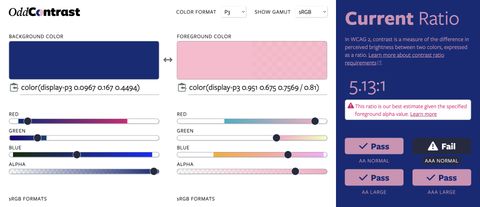I’ve been working on a redesign of my personal site,
and found I was fixing the same issue over and over.
Make the change, test it, commit, and then…
why is it broken again?
The intended behavior
When setting typography in a design,
I like to ‘outdent’ lists –
pulling the list markers
(bullets or numbers)
out into the margin of the document,
so that the list contents align
with the content on either side.
If you’re reading this
on the OddBird website
with a wide enough browser,
you’ll see that we do that here:
- On wide screens, the bullets of this list should be hanging in the margin.
- But on narrow browsers, there’s not enough ‘margin’ available.
- For the list-markers to remain visible on small screens,
we switch to the browser-default
‘hanging indent’ –
list markers aligned to surrounding content,
and list contents indented.
There are various ways we could handle that indent/outdent logic
(and container queries could be useful).
For my site,
I decided to set up an --outdent custom property
on typesetting containers.
The --outdent variable conveys if/when and how much
margin is available for content:
main {
--outdent: 0;
@media (min-width: 40em) {
--outdent: -1em;
}
}
- By default, for small screens, the
--outdent is 0.
- When a container has more space,
I toggle the
--outdent to something like -1em.
Some elements (like figures)
get the outdent applied directly to a margin:
figure {
margin-inline-start: var(--outdent);
}
But the list logic is a bit more complicated.
Since list markers hang ‘outside the list’ by default,
we need 0 list-padding on large screens
and additional padding on small screens
to achieve an indent.
I do that with a calc() function:
ol, ul {
padding-inline-start: calc(1em + var(--outdent));
}
li {
--outdent: 0;
}
There would be other ways to do this of course –
but it made sense to me
as a way of handling different outdent styles
with a single variable toggle.
Sadly, the code above doesn’t work.
Why?
Everything looks right,
and my figure elements outdent as expected –
but the list never indents on small screens.
Looking closer,
it seems the entire calc() function
is considered invalid.
What am I doing wrong?
CSS value types
CSS is a ‘typed’ language.
Every value falls into
one of several
‘data types’ –
like a ‘number’ or ‘length’ or ‘color’.
There are many different types in CSS,
many of them specific to the needs of designers –
and every property has specific ‘type’ requirements:
- A
margin value must be a <length>
- A
background-color must be a <color>
- An
animation-duration must be a <time>
- A
line-height can be a <number> or a <length>,
but the two types are handled differently
The only difference between a <number>,
a <length>, and a <time> is in the units applied.
A <number> like 1 becomes a <length>
if you add length-units (1px, 1em, etc)
and a <time> if you add time-units (1s, 1ms, etc).
In some cases, 1 can even be a <string>.
While CSS counters
are clearly counting with numbers,
the output from counter() and counters()
will always be a <string> representation of that count.
For now, the same is true for output of the attr() function.
That’s part of why we can’t (currently)
use counters & attributes to do much outside generated content.
(The other reason is that these functions only work in the content property,
but the logic of that is a bit recursive –
if the only output is a <string>,
and only content accepts <string> values,
there’s no reason to allow counters anywhere else.)
And CSS doesn’t generally allow coercing values
from one type to another.
There’s no way to take a string and turn it into a number,
or vice versa.
We can convert a number into a length (or time) –
calc(<number> * <length>) will return a <length> value –
but we can’t (yet) go the other way:
.example {
--number: 3;
margin-block: calc(var(--number) * 1em);
}
Zero is (often) special
In most cases, zero is an exception to the type rules –
we can use it in many places as either a <number> or a <length>
without adding any units!
That’s because 0 is the same length (no length!),
no matter what units you apply to it.
Zero em is the same as zero px and zero % and so on.
You can’t set margin to 5 (a <number>),
but you can set it to 0 (also a <number>).
For zero and only zero,
we can use a <number> when CSS expects a <length>.
And over time,
that has become a ‘best practice’ –
often enforced by CSS linters & minifiers.
The usual reasoning is performance.
Removing all the units from zeros
will save you a couple bytes
for every occurrence.
You could also consider it better for readability –
if all zero values are equal,
units only distract from the meaning.
Zero is (not always) special
That ‘best practice’ works great
for raw zero values,
directly applied to properties like
margin or padding –
but there are other places
where this ‘best practice’ will break your CSS.
In general:
when zero is inside a function, the type of zero matters.
(At least,
that’s where I’ve always encountered the issue.)
While the rgb() function
accepts either <number> (0-255)
or <percentage> (0%-100%) values,
you are not allowed to combine both types:
html {
color: rgb(0 60 80);
color: rgb(0% 60% 80%);
color: rgb(0% 60 80);
color: rgb(0 60% 80%);
}
Other color functions have more strict requirements.
In hsl() only the hue value can be a <number> or <angle>,
but the lightness and saturation must be percentages:
html {
color: hsl(0 60% 80%);
color: hsl(0deg 60% 80%);
color: hsl(60 0 80);
color: hsl(60deg 0 80%);
}
The same is true inside the calc() function.
Numbers can be added or subtracted with other numbers,
and lengths can be added or subtracted with other lengths.
It is invalid to add or subtract a number with a length.
And that is true even if the number or length is zero:
See the Pen some zeros need units by @miriamsuzanne on CodePen.
It turns out this is also documented
in the specification
for the calc() function:
Note: Because <number-token>s
are always interpreted as <number>s or <integer>s,
“unitless 0” <length>s aren’t supported in math functions.
That is, width: calc(0 + 5px); is invalid,
because it’s trying to add a <number> to a <length>,
even though both width: 0; and width: 5px; are valid.
Fixing the outdent use-case
This is the issue with my --outdent code above:
ol, ul {
padding-inline-start: calc(1em + var(--outdent));
}
li {
--outdent: 0;
}
When --outdent is zero (without any units),
the calc() function becomes calc(0 + 1em) –
a <number> being added to a <length> –
which is invalid.
The entire declaration is ignored,
and no padding is applied.
The fix is simple:
add units to the --outdent,
even when the value is zero:
li {
--outdent: 0px;
}
And the reason that I keep fixing this same issue
over and over
is because I use a linter that doesn’t understand the issue.
That linter runs every time I commit my code,
and wipes out the units that I’ve supplied.
Be cautious with linting & minification
Depending on the linter,
I can likely turn off that particular ‘optimization’ –
Stylelint allows turning it off
in custom properties specifically.
That’s fine.
I understand
that it is not easy to account for every edge case
in the default settings.
There will always be issues that come up.
But these problems are exacerbated
by tools like linters & minifiers
which apply opinionated transformations
to already-valid code.
I had a similar issue last week,
with a CSS minifier
removing all Cascade Layers from my CSS.
In one case,
the transformation is an over-eager ‘best practice’.
In the other it’s an over-eager attempt
to remove ‘unknown syntax’.
In both cases,
I wish linters and minifiers
would be less eager to transform my code.
I think we (as an industry)
tend to adopt rules and ‘best practices’ very quickly,
without communicating the caveats clearly,
and then we fail to update our understanding as things change.
Tools based on these ‘best practice’ trends
need to be written and also used with caution.
They should generally not transform unknown syntax,
which includes values inside custom properties –
where nearly any value is allowed,
and the purpose of the property is unknown.



